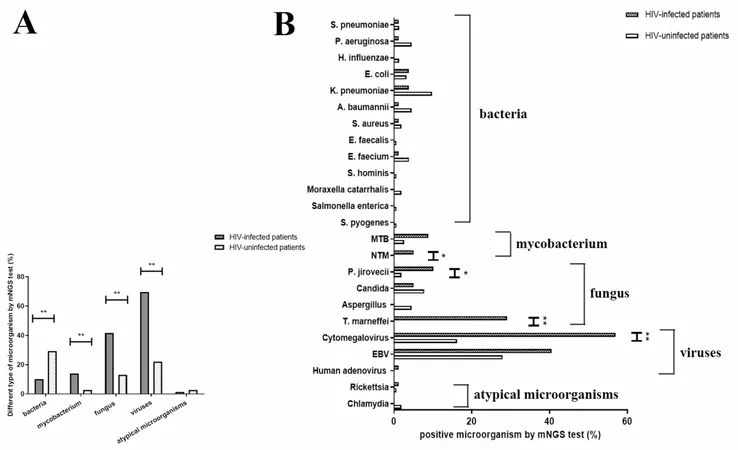
Uncovering the Blood Microbiome: Surprising Findings in HIV-Infected and Uninfected Patients with Sepsis
2024-10-28
Author: Nur
A groundbreaking study from Changsha has revealed intriguing differences in the blood microbiomes of patients with suspected sepsis, particularly distinguishing between those who are HIV-infected and those who are not. This research, spanning from March 2019 to August 2022, retrospectively analyzed blood samples using metagenomic next-generation sequencing (mNGS) to identify microbial presence in these patients.
Study Overview and Patient Profile
The study included a detailed review of 249 patients exhibiting suspected sepsis symptoms. After applying strict inclusion and exclusion criteria—excluding individuals under 18, those with unknown HIV status, and patients with non-infectious causes of fever—233 patients were eligible. Among these, 79 were HIV-infected, and 154 were HIV-uninfected. Results showed that HIV-infected patients were generally younger, with a notably lower lymphocyte count and a lower percentage of males compared to their uninfected counterparts.
Methodology
Blood mNGS was performed on all participants to extract microbial DNA, facilitating the construction of a comprehensive library for high-throughput sequencing. The findings revealed a significantly higher proportion of viral and fungal pathogens in HIV-infected patients, including the presence of Mycobacterium tuberculosis (MTB) and strains of non-tuberculous mycobacteria (NTM).
Major Findings
The results were staggering:
1. Microbial Diversity: - HIV-infected patients had a greater prevalence of viruses (69.62%) and fungi (41.77%), whereas HIV-uninfected patients had a higher presence of bacteria (29.22%). The unique detection of virulent strains like Talaromyces marneffei in HIV-infected individuals underscores the severe immunocompromised state resulting from HIV.
2. Pathogen Profiles: - HIV-infected patients exhibited significantly higher rates of opportunistic infections such as Pneumocystis jirovecii and Cytomegalovirus compared to HIV-uninfected patients. This highlights the ongoing challenge physicians face in managing complex infections in this population.
3. Contrasting Infections: - Interestingly, while common pathogens such as Klebsiella pneumoniae and E. coli were prevalent in both groups, the constituent ratios of certain fungi like T. marneffei were dramatically elevated among HIV-infected patients. In contrast, the prevalence of Candida and Aspergillus was considerably lower, suggesting a possible shift in infection dynamics due to immunological factors.
4. Mortality Rates: - Bloodstream infections are not only common but also a leading contributor to increased mortality among HIV-infected individuals. The study emphasizes the need for swift and appropriate treatment strategies, particularly considering the higher identification of mixed infections in these patients.
Clinical Significance
This study is pivotal in shaping our understanding of how HIV modifies microbial communities in the bloodstream, particularly during septic episodes. The implications for early diagnosis and the need for targeted treatment strategies are crucial. Furthermore, with the alarming rise of antibiotic-resistant pathogens, precise identification through mNGS could aid in guiding therapeutic decisions effectively.
Conclusion
While the study presents a wealth of information on the blood microbiomes of HIV-infected individuals, it does raise questions about the broader implications of microbial diversity in infection control and treatment efficacy. As we continue to unravel the complexities of the HIV-related microbiome, the urgency for comprehensive therapeutic protocols becomes increasingly clear. This research may just be the tip of the iceberg in understanding the intricate relationship between HIV and its associated infections, leading to more effective management strategies in the future.
Stay tuned for further updates on this essential field of study, as the quest for improved health outcomes in HIV-infected individuals continues.



 Brasil (PT)
Brasil (PT)
 Canada (EN)
Canada (EN)
 Chile (ES)
Chile (ES)
 Česko (CS)
Česko (CS)
 대한민국 (KO)
대한민국 (KO)
 España (ES)
España (ES)
 France (FR)
France (FR)
 Hong Kong (EN)
Hong Kong (EN)
 Italia (IT)
Italia (IT)
 日本 (JA)
日本 (JA)
 Magyarország (HU)
Magyarország (HU)
 Norge (NO)
Norge (NO)
 Polska (PL)
Polska (PL)
 Schweiz (DE)
Schweiz (DE)
 Singapore (EN)
Singapore (EN)
 Sverige (SV)
Sverige (SV)
 Suomi (FI)
Suomi (FI)
 Türkiye (TR)
Türkiye (TR)
 الإمارات العربية المتحدة (AR)
الإمارات العربية المتحدة (AR)